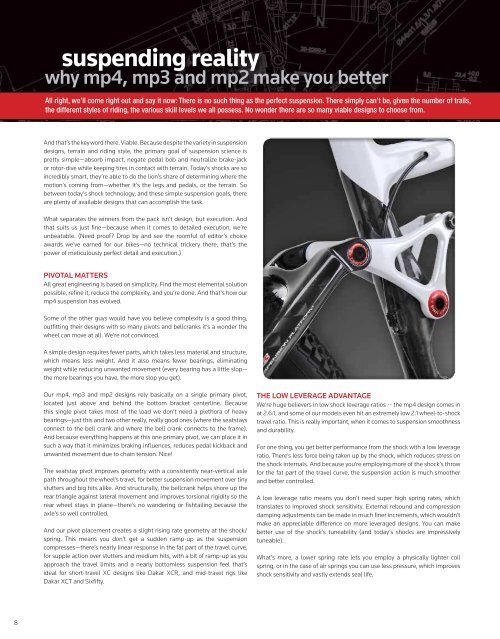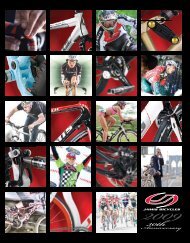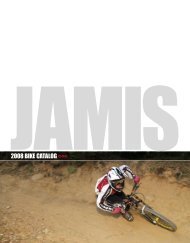Create successful ePaper yourself
Turn your PDF publications into a flip-book with our unique Google optimized e-Paper software.
suspending realitywhy mp4, mp3 and mp2 make you betterAll right, we’ll come right out and say it now: There is no such thing as the perfect suspension. There simply can’t be, given the number of trails,the different styles of riding, the various skill levels we all possess. No wonder there are so many viable designs to choose from.And that’s the key word there. Viable. Because despite the variety in suspensiondesigns, terrain and riding style, the primary goal of suspension science ispretty simple—absorb impact, negate pedal bob and neutralize brake-jackor rotor-dive while keeping tires in contact with terrain. Today’s shocks are soincredibly smart, they’re able to do the lion’s share of determining where themotion’s coming from—whether it’s the legs and pedals, or the terrain. Sobetween today’s shock technology, and these simple suspension goals, thereare plenty of available designs that can accomplish the task.What separates the winners from the pack isn’t design, but execution. Andthat suits us just fine—because when it comes to detailed execution, we’reunbeatable. (Need proof? Drop by and see the roomful of editor’s choiceawards we’ve earned for our bikes—no technical trickery there, that’s thepower of meticulously perfect detail and execution.)PIVOTAL MATTERSAll great engineering is based on simplicity. Find the most elemental solutionpossible, refine it, reduce the complexity, and you’re done. And that’s how ourmp4 suspension has evolved.Some of the other guys would have you believe complexity is a good thing,outfitting their designs with so many pivots and bellcranks it’s a wonder thewheel can move at all. We’re not convinced.A simple design requires fewer parts, which takes less material and structure,which means less weight. And it also means fewer bearings, eliminatingweight while reducing unwanted movement (every bearing has a little slop—the more bearings you have, the more slop you get).Our mp4, mp3 and mp2 designs rely basically on a single primary pivot,located just above and behind the bottom bracket centerline. Becausethis single pivot takes most of the load we don’t need a plethora of heavybearings—just this and two other really, really good ones (where the seatstaysconnect to the bell crank and where the bell crank connects to the frame).And because everything happens at this one primary pivot, we can place it insuch a way that it minimizes braking influences, reduces pedal kickback andunwanted movement due to chain tension. Nice!The seatstay pivot improves geometry with a consistently near-vertical axlepath throughout the wheel’s travel, for better suspension movement over tinystutters and big hits alike. And structurally, the bellcrank helps shore up therear triangle against lateral movement and improves torsional rigidity so therear wheel stays in plane—there’s no wandering or fishtailing because theaxle’s so well controlled.And our pivot placement creates a slight rising rate geometry at the shock/spring. This means you don’t get a sudden ramp-up as the suspensioncompresses—there’s nearly linear response in the fat part of the travel curve,for supple action over stutters and medium hits, with a bit of ramp-up as youapproach the travel limits and a nearly bottomless suspension feel that’sideal for short-travel XC designs like Dakar XCR, and mid-travel rigs likeDakar XCT and Sixfifty.THE LOW LEVERAGE ADVANTAGEWe’re huge believers in low shock leverage ratios -- the mp4 design comes inat 2.6:1, and some of our models even hit an extremely low 2:1 wheel-to-shocktravel ratio. This is really important, when it comes to suspension smoothnessand durability.For one thing, you get better performance from the shock with a low leverageratio. There’s less force being taken up by the shock, which reduces stress onthe shock internals. And because you’re employing more of the shock’s throwfor the fat part of the travel curve, the suspension action is much smootherand better controlled.A low leverage ratio means you don’t need super high spring rates, whichtranslates to improved shock sensitivity. External rebound and compressiondamping adjustments can be made in much finer increments, which wouldn’tmake an appreciable difference on more leveraged designs. You can makebetter use of the shock’s tuneability (and today’s shocks are impressivelytuneable).What’s more, a lower spring rate lets you employ a physically lighter coilspring, or in the case of air springs you can use less pressure, which improvesshock sensitivity and vastly extends seal life.EMBRACING ASYMMETRYFor <strong>2011</strong>, all of our dual suspension designs feature asymmetric chainstays,with an elevated straight stay on the non-drive side and a dropped, curvingstay on the drive side. A straight stay uses a shorter, lighter length of material,and because it’s better aligned with suspension forces we can pare even moreweight from it without giving up rigidity. The drive side is dropped and curvedto clear the front derailleur and chain, and it’s shored up a bit since it also hasto resist drivetrain forces. It’s not the esthetically balanced look we’re usedto, but the net result is less weight, more rigidity, lots of tire clearance andsmoother suspension action.BUILT TO LASTLightness is good, but strength is paramount. That’s why we spec 10 mmshock hardware, oversize pivot bearings and high-grade fasteners throughoutthe suspension. You get greater lateral stiffness and torsional rigidity, whichpays off in better handling and power delivery that more than makes up anytime lost by carrying a few additional grams.We carry that weight as low as possible, which is why we like our low shockmounting position that lowers the center of gravity for better handling. Andwe believe in the structural bracing power of the triangle. Having two of themin our suspension designs makes for a stronger, stiffer frame, qualities wemaximize by keeping those triangles as small and tight as physical geometryallows for any given frame size (and also offers the lowest possible standoverfor the rider).We’re also adding a little bit of extra weight in the form of the 135x12mmMaxle thru-axle, which we use on our XCT and Sixfifty B designs becauseit just brings so much to the table. There’s a huge payoff here—threadingthe rear axle into the dropouts really ties the whole rear triangle together,boosting torsional and lateral stiffness—so you get more efficient powerdelivery, and handling improves markedly since the rear tire’s forced to trackdirectly behind the frame. Suspension pivots last longer, with less binding—and you experience better control under braking, with less fishtailing. It’s awin!CONTROL CENTERA better rear suspension means you’ll go faster. And that places moredemands on the fork. More speed translates into higher cornering forces andbraking forces, which is why we’ve beefed up the front end on almost every<strong>Jamis</strong> mountain bike for <strong>2011</strong>, with a tapered 1-1/8” – 1.5” head tube.The fork transfers most of its force into the frame via the lower headsetbearing, and a 1.5” lower headset is markedly stronger than the old 1-1/8”standard. A full 1.5” head tube would accomplish the same task, but thatoversize top bearing is overkill—it just bulks up the front end and addsunnecessary weight, which is why we’re glad most fork makers are embracingthe tapered steerer design, so we can employ this frame spec without limitingour fork options.A stiffer front end reduces brake chatter and gives you better steeringprecision. Plus a more rigid control center lets you muscle your way out ofruts, blast through rock gardens, and hold your line while bombing g-outsand railing through berms.REAL WORLD PERFORMANCEWe believe in the power of design and details, and <strong>Jamis</strong> does both right.From pivot placement, to just the right size tubing and materials, to thecomponent package, to frame alignment, it’s the manufacturing and partsspecification details, not just the suspension design, that makes or breaks theride. And we believe nobody is better at this game than we are.If you’re shopping for a bike, you owe it to yourself to check them ALL out.Keep your eye on the big picture—does it fit your physique, your trails andriding style? In the end, what matters most is how the bike performs, in realwoods, on real trails, for you. Just be sure you try a <strong>Jamis</strong>—we think you’ll likethe way it works in the real world.8 9










